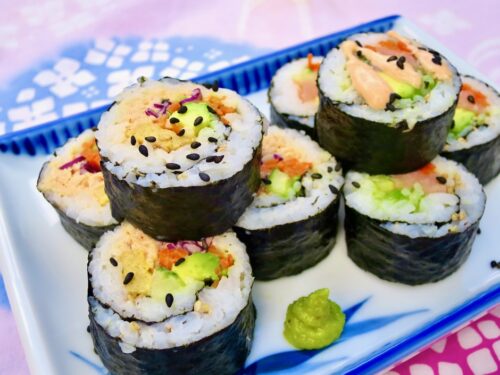
Short Description:
Sushi is a traditional Japanese dish that has gained worldwide popularity for its unique flavors, artistic presentation, and health benefits. Made with vinegared rice, fresh fish, vegetables, and seaweed, sushi is a versatile dish that can be customized to suit your taste. Whether you’re a sushi novice or a seasoned chef, this guide will walk you through the process of making sushi at home, complete with a detailed ingredients list, step-by-step instructions, nutrition facts, and expert tips.

Ingredients List
Here’s what you’ll need to make sushi at home:
- Sushi Rice: 2 cups short-grain Japanese rice
- Rice Vinegar: 4 tablespoons
- Sugar: 2 tablespoons
- Salt: 1 teaspoon
- Nori Sheets: 5-6 sheets (roasted seaweed)
- Fresh Fish: 200g sushi-grade salmon or tuna (optional)
- Vegetables: 1 cucumber, 1 avocado, 1 carrot (thinly sliced)
- Soy Sauce: For serving
- Wasabi and Pickled Ginger: For serving (optional)
- Sesame Seeds: 1 tablespoon (optional)
- Bamboo Sushi Mat: For rolling
Step-by-Step Recipe
Step 1: Prepare the Sushi Rice
- Rinse 2 cups of sushi rice under cold water until the water runs clear.
- Cook the rice in a rice cooker or pot according to package instructions.
- In a small bowl, mix rice vinegar, sugar, and salt. Heat gently until dissolved.
- Once the rice is cooked, transfer it to a large bowl and gently fold in the vinegar mixture. Let it cool to room temperature.
Step 2: Prepare the Fillings
- Slice the fish, cucumber, avocado, and carrot into thin, even strips.
- Set aside all fillings in separate bowls for easy assembly.
Step 3: Assemble the Sushi Rolls
- Place a bamboo sushi mat on a clean surface and put a sheet of nori on top.
- Wet your hands and spread a thin layer of sushi rice evenly over the nori, leaving a 1-inch border at the top.
- Sprinkle sesame seeds over the rice (optional).
- Arrange your fillings (fish, vegetables) in a line across the center of the rice.
- Lift the edge of the mat and gently roll the sushi away from you, pressing firmly to shape it.
- Seal the roll by moistening the nori border with water.
Step 4: Cut and Serve
- Use a sharp knife to slice the roll into 6-8 pieces.
- Serve with soy sauce, wasabi, and pickled ginger on the side.
Nutrition Facts
Sushi is not only delicious but also packed with nutrients. Here’s a breakdown of its nutritional value per serving (6 pieces):
- Calories: 200-300 kcal
- Protein: 8-12g (from fish and rice)
- Carbohydrates: 30-40g (mainly from rice)
- Fats: 3-6g (healthy fats from avocado and fish)
- Fiber: 2-4g (from vegetables and seaweed)
- Vitamins and Minerals: Rich in omega-3 fatty acids, vitamin A, vitamin C, and iodine.
Health Benefits of Sushi
- Rich in Omega-3 Fatty Acids: Fish like salmon and tuna are excellent sources of omega-3s, which support heart and brain health.
- Low in Calories: Sushi is a light and satisfying meal, making it a great option for weight management.
- High in Protein: The combination of fish and rice provides a balanced source of protein.
- Packed with Antioxidants: Seaweed (nori) is rich in antioxidants that boost immunity and promote skin health.
- Gluten-Free Option: Sushi can easily be made gluten-free by using tamari instead of soy sauce.
Ending Notes and Tips
- Use Sushi-Grade Fish: Always ensure your fish is sushi-grade to avoid foodborne illnesses.
- Keep Ingredients Fresh: Freshness is key to great sushi, so use high-quality ingredients.
- Practice Rolling: Rolling sushi takes practice, so don’t worry if your first few attempts aren’t perfect.
- Experiment with Fillings: Try different combinations like tempura shrimp, cream cheese, or mango for a unique twist.
- Serve Immediately: Sushi tastes best when served fresh, so avoid making it too far in advance.








